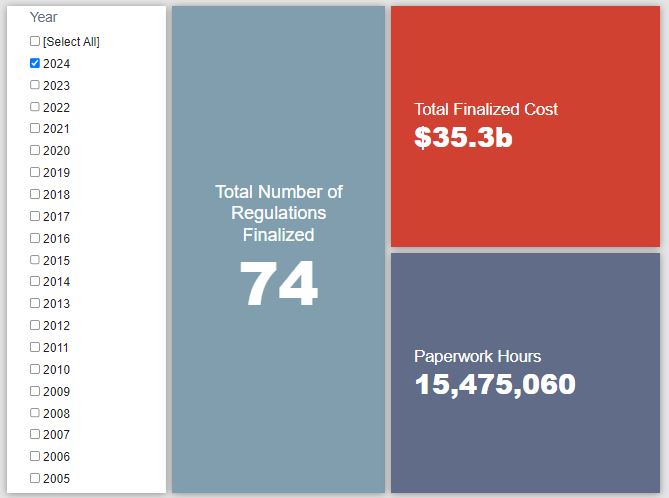Week in Regulation
April 1, 2024
Environmental Risk Rules Drive Sizable Week
Last week was a fairly busy one in the pages of the Federal Register. There were 15 rulemakings with some measurable economic impact. Two of these rules involved costs in the billions of dollars, and notably, both focused on environmental risk factors – albeit in quite different ways. The main item of the week was the Securities and Exchange Commission’s (SEC) long-awaited “climate risk disclosure” rule, but an Environmental Protection Agency (EPA) rule regarding the discharge of hazardous materials into water was the clear runner-up. Across all rulemakings, agencies published $4.5 billion in total costs and added 4.1 million annual paperwork burden hours.
REGULATORY TOPLINES
- Proposed Rules: 41
- Final Rules: 42
- 2024 Total Pages: 22,292
- 2024 Final Rule Costs: $35.3 billion
- 2024 Proposed Rule Costs: $31.9 billion
NOTABLE REGULATORY ACTIONS
The most consequential rulemaking of the week was the final rule from SEC regarding “The Enhancement and Standardization of Climate-Related Disclosures for Investors.” The rule requires publicly traded companies to “provide certain climate-related information in their registration statements and annual reports.” The American Action Forum (AAF) summarized some of the core issues of the rule here. While the final rule represents a pared-back version from its proposed iteration – due primarily to SEC scrapping the so-called “Scope 3” disclosures for most companies – the compliance burdens are still notable with roughly 3.2 million hours of paperwork and $900 million in associated costs annually.
The other significant action of the week was the EPA rule on “Clean Water Act [CWA] Hazardous Substance Facility Response Plans.” As the brief title suggests, the rule is setting:
New requirements for Facility Response Plans for worst case discharges of CWA hazardous substances from onshore non-transportation related facilities (hereafter, covered facilities or facility) that, because of their location, could reasonably be expected to cause substantial harm to the environment by discharging into or on the navigable waters, adjoining shorelines, or exclusive economic zone.
EPA estimates that these new requirements could result in roughly $106 million in annualized costs, or $1.1 billion in total present value terms over a 20-year period. The costs involved are primarily due to the scope of the rule, as it covers thousands of facilities across dozens of industries.
TRACKING THE ADMINISTRATIONS
As we have already seen from executive orders and memos, the Biden Administration will surely provide plenty of contrasts with the Trump Administration on the regulatory front. And while there is a general expectation that the current administration will seek to broadly restore Obama-esque regulatory actions, there will also be areas where it charts its own course. Since the AAF RegRodeo data extend back to 2005, it is possible to provide weekly updates on how the top-level trends of President Biden’s regulatory record track with those of his two most recent predecessors. The following table provides the cumulative totals of final rules containing some quantified economic impact from each administration through this point in their respective terms.![]() Thanks primarily to the rules discussed above, the Biden Administration’s final rule cost and paperwork totals rose by $4.4 billion and 4.1 million hours, respectively. For the other two administrations, there was a divergence in both direction and magnitude. The Trump Administration saw a modest $76 million and 127,000-hour decline in its regulatory tallies, due mostly to a deregulatory action from SEC. Meanwhile, the Obama Administration saw massive upswings in both metrics – $7.2 billion and nearly 34 million hours – with a Department of Labor rule on “Hazard Communication” and a pair of rules implementing aspects of the Affordable Care Act leading the way.
Thanks primarily to the rules discussed above, the Biden Administration’s final rule cost and paperwork totals rose by $4.4 billion and 4.1 million hours, respectively. For the other two administrations, there was a divergence in both direction and magnitude. The Trump Administration saw a modest $76 million and 127,000-hour decline in its regulatory tallies, due mostly to a deregulatory action from SEC. Meanwhile, the Obama Administration saw massive upswings in both metrics – $7.2 billion and nearly 34 million hours – with a Department of Labor rule on “Hazard Communication” and a pair of rules implementing aspects of the Affordable Care Act leading the way.
TOTAL BURDENS
Since January 1, the federal government has published $67.2 billion in total net costs (with $35.3 billion in new costs from finalized rules) and 33.5 million hours of net annual paperwork burden increases (with 15.5 million hours coming from final rules). 










